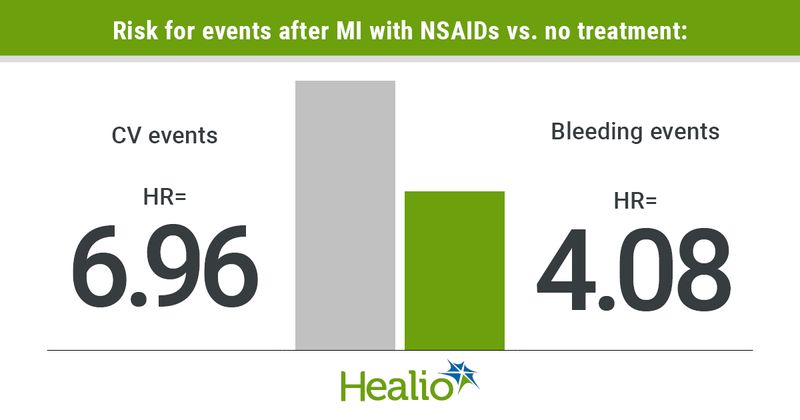NSAIDs increase risk for events after MI
The use of NSAIDs after an MI significantly increased the risk for CV and bleeding events, researchers found.
“This is the first population-based study to investigate the cardiovascular and bleeding risk associated with concomitant NSAID treatment in a non-Western population with MI,” Dong Oh Kang, MD, assistant professor of the Cardiovascular Center at Korea University in Seoul, and colleagues wrote in the study published in the Journal of the American College of Cardiology. “Our study adds important value to the currently available evidence for concomitant NSAID treatment after MI by constituting global evidence that encompasses diverse population groups.”

Researchers analyzed data from 108,232 patients (mean age, 64 years; 72% men) who were admitted for first diagnosed MI in Korea between 2009 and 2013. Baseline comorbidity and demographic data were obtained from the Korean Health Insurance Review and Assessment Service. Researchers also assessed prescription claims for NSAIDs, antithrombotic medications and other concomitant medications.
The primary outcome for this study was thromboembolic CV events, defined as a composite of recurrent MI, transient ischemic attack, ischemic stroke or systemic arterial embolism. The secondary outcome was clinically relevant bleeding events, which were defined as intracranial, gastrointestinal, urinary tract or respiratory bleeding or posthemorrhagic anemia. Follow-up was conducted for a mean of 2.3 years.
Compared with no NSAID treatment, concomitant NSAIDs in the overall population significantly increased the risk for CV events (HR = 6.96; 95% CI, 6.24-6.77) in addition to bleeding events (HR = 4.08; 95% CI, 3.51-4.73).
When assessing NSAID subtypes, the risk for CV events was lowest in patients taking celecoxib (HR = 4.65; 95% CI, 3.17-6.82) and meloxicam (HR = 3.03; 95% CI, 1.68-5.47). This was also observed for bleeding events in those taking celecoxib (HR = 3.44; 95% CI, 2.2-5.39) or meloxicam (HR = 2.8; 95% CI, 1.4-5.6).
“Although NSAID treatment should be limited after MI, selective and relative COX-2 inhibitors could be considered a primary choice on the basis of their observed relative safety profile in patients with MI when NSAID use is unavoidable,” Kang and colleagues wrote.
In a related editorial, Juan J. Badimon, PhD, professor of cardiology and director of the Atherothrombosis Research Unit at the Cardiovascular Institute at the Icahn School of Medicine at Mount Sinai, and Carlos G. Santos-Gallego, MD, instructor at the Cardiovascular Institute, wrote:” Celecoxib and meloxicam showed the least increase in adverse outcomes vs. other NSAIDs, thus they may deserve a more central place in the anti-inflammatory armamentarium. There is no free lunch in medicine, so if NSAID therapy in patients post-MI is inevitable, we have to understand which price we are paying for pain relief.”
